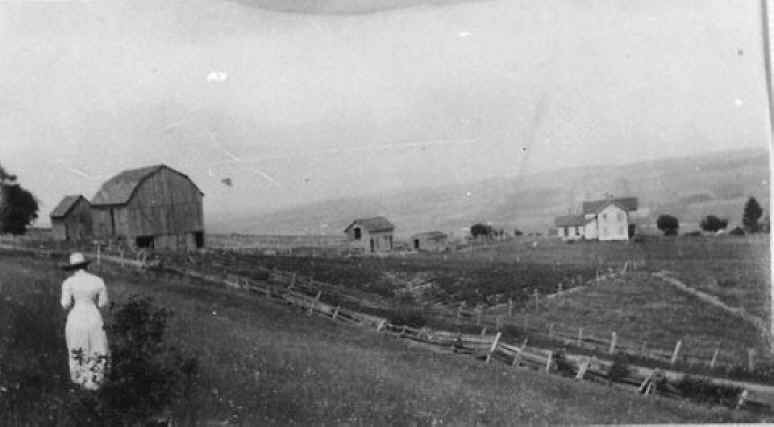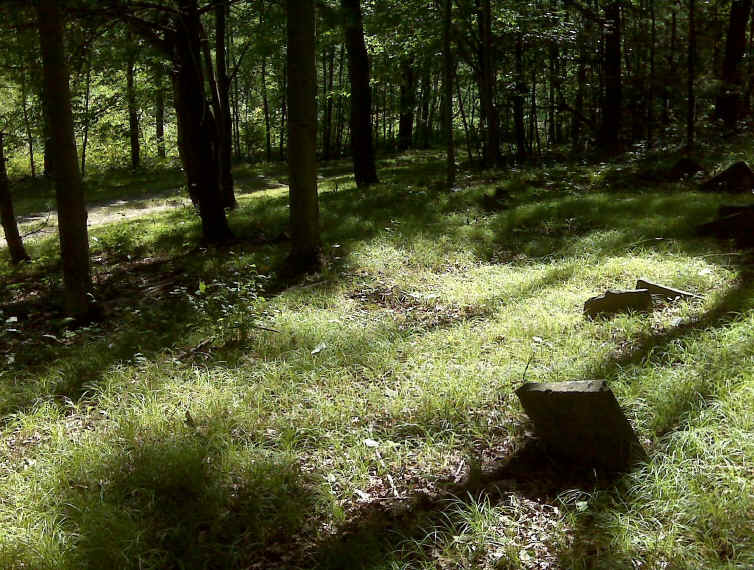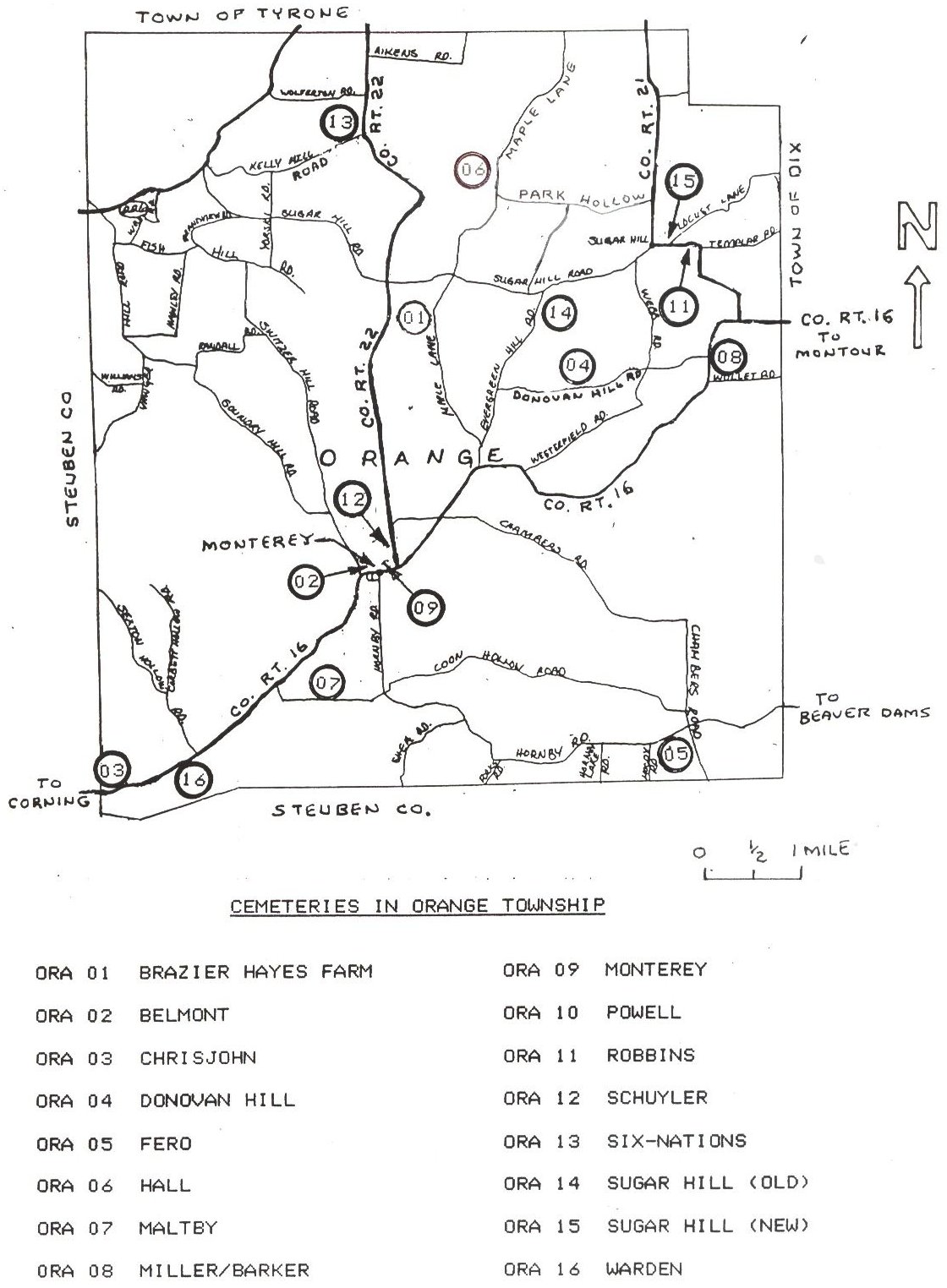Who Owned the “Compton
Farm” on Donovan Hill?
Sources used for this: ·
Correspondence
from Michael Donovan (2012) ·
Hannah Marie
Compton Wells’ obituary (1888) ·
Peter Compton
obituary (1885) ·
Sugar Hill and
Donovan Hill cemeteries ·
Harriet Compton
Robinson 1910 letter. At the end of 2011 I received a most interesting e-mail from someone named Mike Donovan who found me through this website. In his first e-mail he spoke of the graves on Donovan Hill, including the four Compton children who died in 1840, and said the property has been in his family since about 1880. In his second message he elaborated: I am not a Compton but have for many years wondered about the
lives of the first settlers now buried on Donovan Hill. The Hill (1950'+
elevation, near the 2,000 feet of Sugar Hill, highest point in Schuyler
County, 5 miles to the north), might more appropriately have been called
Compton Hill (or mountain in some parts). "Compton farm" of 100-180 acres was conveyed by
deed to Elijah Brooks by A.J Compton and Chad I. [Chas. L.] Compton by
A.J. Compton their lawyer on Oct 19, 1871. In April 1878, my
great-grandfather Patrick Donovan bought the property from Mr. Brooks.
He moved his family there from Elmira, NY, had a working farm, and
raised 13 children there. After his death in 1912, the farm and
most surrounding land was no longer farmed. Now 100 years later, the
property is a forest where we maintain several recreational camps. Virtually all of this was new to me and to those of us who descend from this early American family. We knew there were Comptons, some very young, buried on Donovan Hill and some on Sugar Hill, but I had never heard of a Compton farm on Donovan Hill nor of a Donovan family that farmed it for more than thirty years.
Hilltop area sold by Comptons in 1871 and owned by Donovans since 1878; farmed by Patrick Donovan from then until his death in 1912. The whole area is now forest again and used for camps. The two Comptons who sold the property out of the family were sons of Peter Compton and grandsons of William and Hannah Phebe, but the history of the property before that sale has been a bit of a challenge to reconstruct. Mike had been under the impression that the original owner was named William Compton, while we know from their daughter/my ancestor Hannah’s obituary that in 1821she was born in Tyrone, which is a dozen or so miles north and west of Donovan Hill. Peter’s
Obituary Peter’s obituary says that at one point (no date given) he paid off a piece of land he had long owned and then deeded the land to his sons—but to which land is he referring? We know the land on Donovan Hill had belonged to Peter’s sons—but did Peter ever live and farm there himself? His obituary gives us a good bit of information about his land dealings during his life, but very little with helpful dates. Quoting, except for comments in brackets:
Though the obituary doesn’t give dates for those events, we can piece together a bit from other sources. Bud Compton has prepared a detailed time line of the lives of Peter and his family, and working with both documents gives more information than each one does separately. A straightforward reading of the obituary sounds as if Peter bought the 232 acres, which we believe later went to his sons, after 1836, the end of the time period when he was foreman for Walter Burling. The
Cemeteries In 1840 all the young Comptons were married with a good many young children. Apparently an epidemic struck, and within ten days, five of the Compton grandchildren died. The deaths struck four different families—David and Rachel (Effie, 14), John P and Eliza (Mannerva, 5), William and Elizabeth (Lyman, 3, & Eliza Jane, 8), and Peter and Maria (Harriet, 2). The children of the first three couples are buried in the Donovan Hill plot, or cemetery, but Peter’s Harriet is buried in the Sugar Hill cemetery about five miles north. The spring following the epidemic, another of Peter’s children (Hannah Louise, 16) would also be buried in Sugar Hill.
Some of the headstones on Donovan Hill. It takes a lot of effort to keep them The fact that several family members were buried on Donovan Hill in the fall of 1840—and that it apparently never became a public cemetery—strongly suggests that someone in the family had to own that property by then. The question arises, if in 1840 Peter’s farm and land was at the top of the hill, why wouldn’t he have buried his children there as his siblings did? That answer seems to lie in the fact that nineteen years earlier, he and his wife had buried their firstborn at Sugar Hill, a baby who died the day he was born in1821, and four years later they had buried 2-yr-old Samuel at Sugar Hill.
Key to locations of Orange Twp. cemeteries in Schuyler County Harriet’s Letter We pick up a most helpful clue from a seemingly-in-passing phrase in one of Harriet Compton’s letters (see Voices). She was Peter’s youngest, born in 1840, and she wrote, “After we left Sugar Hill and went to Havanna to live, Granddad came to Havanna and lived with us” (italics mine). In addition to this reference to Peter’s family living in Sugar Hill is the fact that two of his older daughters, in 1833 and 1836, in their own obituaries are reported to have been born at/in Sugar Hill. According to this, then, Peter’s family, at least at some point—and perhaps even a substantial amount of time, lived in the Sugar Hill area. It was simply a post office, not an organized town, but his family lived on a farm. That would explain why Peter buried in the Sugar Hill cemetery the two children he and Maria lost early in their marriage, and years later, in 1840 and 1841, the two sisters who died. The thirty-three years mentioned in the obituary, from his 1819 arrival, gives a date of 1852—which is following the death of both parents. Our best info on Peter’s parents is that Hannah Phebe died in 1841 and William in late 1850. The
Lockwoods Another issue about who owned the hill and when is the fact that Peter’s sister Anna and her husband, Seymour Lockwood, were also buried on Donovan Hill, along with two of their daughters. Does that help us figure out anything? The Lockwoods fourth child, Frederick, at almost 3, died in 1821, early in the days of the families’ arrivals in Steuben County and nineteen years before the epidemic. He is buried at Sugar Hill. When, however, their 20-yr-old daughter Margaret died in 1845, five years after the epidemic, they buried her near her young cousins who had died earlier. When husband and father, Seymour, died seven months after Margaret, they buried him near her, and of course Anna later joined them, though not for another 37 years. In between, Margaret’s sister Catherine died, and she also was buried there. We have not found any evidence of where the Lockwoods bought property and
raised their family, but since the four members of the family are buried
in the Donovan Hill plot, I’m guessing it was in the Donovan Hill
area. The fact that no family burials were made there until 1840
strongly suggests (but stops short of proving) that no one in the family
owned that property in the 1820s when the first family members died. Summary of our current facts and conclusions: Facts
Current
Conclusions (2012)
A HUGE
“but” All this makes good sense to me until I go back and reread the following paragraph in Peter’s obituary: As a
rule times were hard, and though for the greater part of thirty-three
years [makes it about 1852 or 1854] he lived in that place he was
in fair circumstances, he found at the end of that period he still owed
$1,000 on the land. He had sent his daughters to college and fitted his
two boys out to go to California. He finally sold off his stock, went to
California and in a short time by hard work raised $1,000, with which he
paid the balance due on the land, which he then deeded to his sons. There is no denying that this passage sounds as if the land on which he still owed $1000 and which he later deeded to his sons was the land on which he had lived his whole time before his first move to California. But that just doesn’t fit with the facts as I have analyzed them above. Since almost without exception obituaries are written by someone other than the person they are about, is it not possible that the person who wrote Peter’s, in faraway Dakota Territory at least 35 years later, got just a little confused about his property history? For example, does it make sense that the “wild land” Peter claimed and started clearing in 1819 was something he would still owe $1000 on thirty plus years later? After all my study, I find myself believing that
the livestock Peter sold before going to California was on his original homestead farm, but that the $1000 was still owed on the hilltop
land he had purchased fifteen or so years before. That was the land
he deeded to his sons, which we know in 1871 was sold by them to Elijah
Brooks. That land was seen as having been “the Compton Farm,” first
because it was sold by Comptons and, second, perhaps because part of it had
been farmed by William Compton in his later years, or perhaps one of his
other sons who had buried children in the area in 1840. Answers—and
then Questions It’s gratifying that the new information paints for us a much fuller picture than we had before about our Compton predecessors and their lives after their migration to western New York. But as is so often the case in genealogy, we are left with a whole new set of questions! Meanwhile, here's a story about how the Sugar Hill area got its name. |


